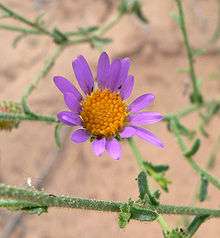Dieteria canescens
| Dieteria canescens | |
|---|---|
 | |
| Scientific classification | |
| Kingdom: | Plantae |
| (unranked): | Angiosperms |
| (unranked): | Eudicots |
| (unranked): | Asterids |
| Order: | Asterales |
| Family: | Asteraceae |
| Genus: | Dieteria |
| Species: | D. canescens |
| Binomial name | |
| Dieteria canescens | |
| Synonyms[1] | |
|
Synonymy
| |
Dieteria canascens (formerly Machaeranthera canescens)[2] is an annual plant or short lived perennial plant in the (daisy family), known by the common names hoary tansyaster and hoary-aster.[3]
"Canescens" means "gray-hairy".[4]
Range and habitat
Dieteria canascens is native to western and central North America, from the Pacific Coast to the Western part of the Great Plains, from British Columbia south to California, Sonora, and Chihuahua, east to Saskatchewan, the Dakotas, and Oklahoma, with a few isolated populations in Iowa and Minnesota.[5]
Growth pattern
Dieteria canascens is a woolly-haired, glandular annual or perennial herb with one or more branching stems sometimes exceeding 100 cm (39 in) in height.[6]
Leaves and stems
The linear to oblong leaves may reach 10 centimetres (3.9 inches) long near the base of the stems, their edges usually serrated or toothed.
Flowers and fruits
The inflorescence bears one or more flower heads lined with several layers of pointed, curling or curving phyllaries. The head has a center of many yellow disc florets and a fringe of blue or purple ray florets each 1 to 2 centimeters long. The fruit is an achene around 3 millimeters in length tipped with a pappus of long hairs.[6]
A number of insects can often be found in the flowers.[3]
Uses
The Zuni people take an infusion the whole plant of subspecies canescens, variety canescens and rub it on the abdomen as an emetic.[7]
- Dieteria canescens var. ambigua (B.L.Turner) D.R.Morgan & R.L.Hartm. – Arizona, Colorado, New Mexico
- Dieteria canescens var. aristata (Eastw.) D.R.Morgan & R.L.Hartm. – Arizona, Colorado, New Mexico, Utah
- Dieteria canescens var. canescens – Alberta, British Columbia, Saskatchewan; Arizona, California, Colorado, Idaho, Montana, Nebraska, Nevada, North Dakota, Oregon, South Dakota, Utah, Wyoming
- Dieteria canescens var. glabra (A.Gray) D.R.Morgan & R.L.Hartm. – Arizona, Colorado, Kansas, New Mexico, Texas, Wyoming, Chihuahua
- Dieteria canescens var. incana (Lindl.) D.R.Morgan & R.L.Hartm. – Nebraska, South Dakota
- Dieteria canescens var. leucanthemifolia (Greene) D.R.Morgan & R.L.Hartm. – California, Nevada, Utah
- Dieteria canescens var. nebraskana (B.L.Turner) D.R.Morgan & R.L.Hartm. – Nebraska, South Dakota
- Dieteria canescens var. sessiliflora (Nutt.) D.R.Morgan & R.L.Hartm. – Idaho
- Dieteria canescens var. shastensis (A.Gray) D.R.Morgan & R.L.Hartm. – California, Nevada, Oregon
- Dieteria canescens var. ziegleri (Munz) D.R.Morgan & R.L.Hartm. – Santa Rosa Mountains in Riverside County in California
References
- 1 2 The Plant List, Dieteria canescens (Pursh) Nutt.
- ↑ Mojave Desert Wildflowers, Pam MacKay, 2nd Ed., p 314
- 1 2 3 Mojave Desert Wildflowers, Pam MacKay, 2nd Ed., p 39
- ↑ Great Basin Wildflowers, Laird R. Blackwell, 2006, p. 26
- ↑ Biota of North America Program 2014 county distribution map
- 1 2 3 4 Flora of North America, Dieteria canescens
- ↑ Stevenson, Matilda Coxe 1915 Ethnobotany of the Zuni Indians. SI-BAE Annual Report #30 (p. 56)